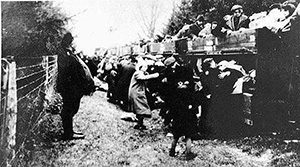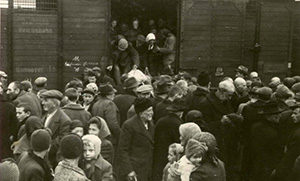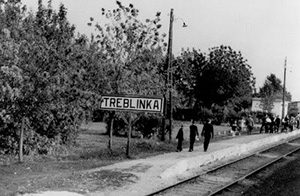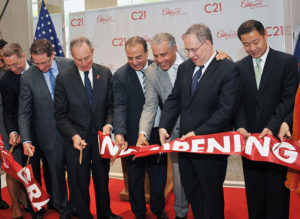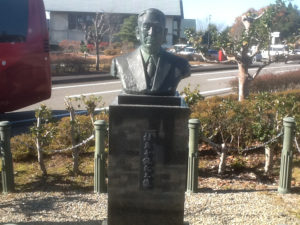
Most Americans know of Oskar Schindler, the German businessman who saved more than 1,200 lives during the Holocaust, by hiring Jews to work in his factories and fought Nazi efforts to remove them. But not so many people know about Chiune Sugihara, the Japanese diplomat who disobeyed his government’s orders and issued visas that allowed 6,000 Jews to escape from Nazi-occupied territories via Japan. His courage and bravery are now praised by thousands of Jews and non-Jews worldwide, and he has been recognized as one of the Righteous among the Nations at Jerusalem’s Yad Vashem Holocaust memorial. The Sugihara Story is a particularly powerful.
I recently visited Gifu Prefecture and the town of Yaotsu, where the residents built the Memorial Hall and the Hill of Humanity Park to honor Chiune Sugihara.. In the Gifu Prefecture, they have preserved an original document, a passport bearing a Curaçao visa together with a Sugihara visa. which was donated by a survivor named Sylvia Smoller and a replica is exhibited in this Hall. Nearby in Jindounooka Park, the name which means “Hill of Humanity,” a bust of Chiune Sugihara is displayed.

The definition of a “hero” — someone who is admired or idealized for his courage and achievements and sacrifices his career, future, family, and possibly one’s life — is synonymous with Chiune Sugihara. For Sugihara, it would be wrong to willfully ignore the plight of the refugees in the interest of protecting himself or his family even at a cost of his own safety that was confronted by his sense of a moral obligation. To refuse the refugees signed visas would, in effect, be the same as offering them signed death certificates. He decided between saving his loved ones and saving hundreds of strangers, Chiune Sugihara chose the latter and his actions saved thousands of Jewish refugees…
Sugihara’s fascinating and incredible life story all started in March 1939 – as Europe stood on the brink of World War II – Sugihara was appointed to open a Consulate in Kaunas, Lithuania and he had barely settled down into his new post when the German army invaded Poland, with a wave of 15,000 Jewish refugees streamed into Lithuania, bringing terrifying stories of German atrocities. Caught between the Nazis and the Soviets, they were desperately seeking ways to emigrate; the Soviets only allowed peoples to pass through Russia if they had a transit visa, issued by Japan, so obtaining a Japanese visa became a matter of life and death.

When Lithuania was annexed to the Soviet Union in the summer of 1940, all foreign diplomats were asked to leave Kaunas and the Jewish delegation came with a desperate request: as it had become impossible to obtain immigration visas to anywhere in the world, the only possibility was to go to Curacao – a Dutch colony – that required no entry visas. Japanese transit visas were necessary in order to obtain permission to cross to the Soviet Union, to reach the port of Vladivostock, from which the Jews could sail from. Facing all these women, children, and elderly with pleading eyes made Sugihara feel helpless. He wanted to help, but had no authority to issue visas without permission from the Foreign Ministry in Tokyo and wired his government three times requesting to issue these visas, and all three times he was denied.
Confronted by the plight of the refugees that camped outside his house in hope of assistance, Sugihara defied his government’s orders and endangered himself and his family by hand-writing and issuing hundreds of visas to these Jewish refugees. He was guided by the strength of his morality, and issued these transit visas for 29 days, as he sat for endless hours composing them. Hour after hour, day after day, he wrote and signed 300 visas a day all written entirely by hand and by the time he had to leave Kaunas, thousands of Jews received these visas. But even as Sugihara’s train was about to leave the city, he kept writing visas from his open window. When the train began moving, he gave the visa stamp to a refugee to continue the job. “We will never forget you.” Those were the last words he heard from the refugees. As Sugihara yelled out, “Please forgive me. I cannot write anymore. I wish you the best.”

The resident at the port Tsuruga, warmly welcomed the sudden appearance of the large number of Jewish refugees, a wide variety of actions in support were carried out, such as providing food to these refugees and opening public baths just for them. Without such cooperation of the people in Tsuruga, thousands of Jewish refugees could not possibly have been sent safely to their final destination, the last stop on their journey to freedom.
It should be also pointed out that the credit for saving these refugees should also be shared with those who have aided him, that is two other men of conscience: Jan Zwartendijk, acting Dutch consul in Lithuania, and L.P.J. de Decker, Dutch ambassador to Latvia, both of whom took risks at least as great as Sugihara had, as their country had been occupied by Germany since May 1940. Zwartendijk and de Decker acceded to granting of entry visas to Curacao, the Dutch colony in the Caribbean, without taking the necessary steps to get them authorized at the other end. It was a similar scenario on a smaller scale as for Chiune Siguhara.
 Being a humble and a modest man, Sugihara never mentioned his wartime deeds to anyone, and the world knew little of him until almost 30 years later, in 1968, when Joshua Nishri, the Economic Attache to the Israeli Embassy in Tokyo located him in Tokyo with one of his survivors. The reunion was most significant for Sugihara, since – for all these years – he had not known whether the visas he signed had actually aided any refugees in fleeing Lithuania. His acknowledgement that so many people made it to safety brought tears of joy to Sugihara’s eyes and was overwhelmed with satisfaction and happiness and with no regrets. Even if only one life had been saved, he felt that all of his hardships would have been worth it. As it is quoted in the Talmud “whoever saves a life, it is considered as if he saved an entire world.”
Being a humble and a modest man, Sugihara never mentioned his wartime deeds to anyone, and the world knew little of him until almost 30 years later, in 1968, when Joshua Nishri, the Economic Attache to the Israeli Embassy in Tokyo located him in Tokyo with one of his survivors. The reunion was most significant for Sugihara, since – for all these years – he had not known whether the visas he signed had actually aided any refugees in fleeing Lithuania. His acknowledgement that so many people made it to safety brought tears of joy to Sugihara’s eyes and was overwhelmed with satisfaction and happiness and with no regrets. Even if only one life had been saved, he felt that all of his hardships would have been worth it. As it is quoted in the Talmud “whoever saves a life, it is considered as if he saved an entire world.”
Despite of all the publicity given to him in Israel and other nations, he remained virtually unknown in his home country. It was only when a large international Jewish delegation attended his funeral , that his own people discovered his great altruistic deeds. In 1985, Sugihara was the only Japanese person to be awarded the “Righteous Among the Nations”, a title by Yad Vashem on behalf of Israel and the Jewish people, an honorary title given to non-Jews who risked their lives to save Jews during the Holocaust. A monument was erected on a hill in Jerusalem, a cedar grove was planted in Sugihara’s name at Yad Vashem, and a park in Jerusalem was named in his honor. A street in Netanya, Israel was named after Sugihara in June 2016, in a ceremony attended by one of Sugihara’s sons, Nobuki. With Sugihara`s visas, as many as 6,000 refugees were able to flee, making their way to Japan, China, and numerous other countries in safety and known as “Sugihara Survivors”. Now he is considered a hero in Japan, and the refugees he saved have more than 40,000 descendants.
When visiting the Gifu Prefecture, Mr. Hiroshi Matsumoto, President of JTB ( Japan Travel Bureau) noted the creation of a route called “ Tourism of Humanity “ that includes the following places : The Chiune Sugihara Memorial Hall dedicated to the virtues of morality and peace and visitors will learn about his life which is dedicated to his memory. Inside the hall there are not only documents and materials about his life and work, but also an exhibit of the Holocaust. English and Hebrew translations of the exhibits are provided for foreign visitors. We can also find a replica of Sugihara’s Lithuanian diplomat office, where he issued the ‘Visas for Life’. The Chiune Sugihara Memoriale Hall and the Hill of Humanity Park was built to honor his achievements and preserve his memory for future generations.
The Port of Humanity Museum in Tsuruga features panels and videos that present the history of Tsuruga Port. The Museum displays articles, photos, of some 6,000 Jewish refugees who fled from Nazi Germany in 1940 carrying “visas for survival” issued by Chiune Sugihara. There are also many heartwarming stories about interactions they had with local residents.
As the governor of Gifu prefecture, Mr. Hajime Furuta explained, “in the last few years, the region has seen an increase of foreign tourists, especially those interested in learning about Chiune Sugihara. Many tourists also visit and stay at various world heritage towns such as Takayama and Shirakawa-go.”
According to Mr. Ken Takashima, Town Promotion Office, Yaotsu Town there are ” over 15,000 Israeli and Jewish tourists from all over the world visiting the Gifu area and in particular “the Sugihara memorial places”. It was also noted by Mr. Hiroshi Matsumodo, President of JTB – (Japan Travel Bureau) that “last year the Gifu Prefecture and JTB formed an agreement in working together not only to honor Sugihara but to share his legacy to the rest of the world and to expand our effort to increase tourism in the Gifu prefecture for the Chiune Siguhara route “ Tourism of Humanity”. A part of this effort, they have opened an information centers in New York City and Los Angeles.
To conclude, Sugihara wrote in his 1983 memoir ” To be perfectly honest, I am convinced to this day that I took that path of action faithfully, putting my job on the line, without fear or trepidation in my heart.” And perhaps the following words were the most eloquent on his contribution to humanity: “I took it upon myself to save (the refugees). If I was to be punished for this, there was nothing I could do about it. It was my personal conviction to do it as a human being. Now, Gifu officials are confident and pursuing the registration of UNESCO Memory of the World for the materials and documents related the vast number of visas he had issued. Certainly, his actions should not just be left as records, but preserved as memory and to perpetuate his legacy. Hopefully the story of this Japan’s admirable diplomat will reach the corners of the world. (New York Jewish Travel Guide & New York Jewish Guide)
For more information, visit:
To plan a trip to Japan, contact the GIFU PREFECTURAL GOVERNMENT or log on to: https://www.kankou-gifu.jp/
By: Meyer Harroch
The post Chiune Sugihara, “Japanese Hero to the Jews” appeared first on Jewish Voice.
 The 75th Golden Globes held its annual celebrity schmoozefest on January 7, 2018 with the show starting at 8:00 PM. This normally lighthearted show ushers in the beginning of the unbearable Hollywood Awards season where pretty looking people pontificate to the public. This night has taken a turn for the worst the past two years with Meryl Streep delivering an ugly tirade against Donald Trump last year.
The 75th Golden Globes held its annual celebrity schmoozefest on January 7, 2018 with the show starting at 8:00 PM. This normally lighthearted show ushers in the beginning of the unbearable Hollywood Awards season where pretty looking people pontificate to the public. This night has taken a turn for the worst the past two years with Meryl Streep delivering an ugly tirade against Donald Trump last year.


















